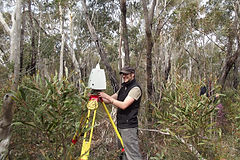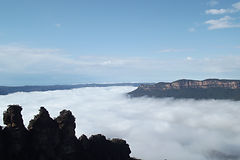
The
RAMP
L
B
Ecoclimatology
CURRENT RESEARCH PROJECTS

The role of vegetation structure in dampening climate extremes
NSW Environmental Trust 2012-2013
John Gollan, Mick Ashcroft and Daniel Ramp
It is well-known that a dense foliage canopy can reduce exposure to extreme temperatures, yet the buffering effect of understorey vegetation has been poorly studied. Since management activities such as revegetation and controlled burning can significantly modify the structure of habitats, there is a pressing need to understand how these activities affect local climate, and in-turn, biodiversity. This project is using a 3D terrestrial LiDAR to quantify the relative contribution of different layers to inform land managers on how best to buffer against climate change and further improve planning tools as part of threat abatement strategies for climate change.

Innovative approaches to identifying regional responses of biodiversity to climate change
Australian Research Council Linkage Grant LP0100200080 (2010-2013)
Partnered by the Australian Museum, NSW Office of Water, and the Central-West Catchment Management Authority. Daniel Ramp, David Warton, John Gollan, Kim Jenkins, Patrick Driver and Mick Ashcroft.
Australia is facing a biodiversity extinction crisis that is likely to be exacerbated by climate change. Existing
models of climate at regional scales require significant advancement, not only to better understand impacts
on biodiversity, but also to assist with decision making and adaptation strategies. This project aims to produce innovative and robust climate maps that are at a scale that is relevant for regional management, enabling us to predict how management actions interact with climate change to affect climate and biodiversity. We also aim to
identify climate refugia and quantify the effectiveness of existing processes of conservation decision making.

An innovative approach to maximising catchment water yield in a changing climate
Australian Research Council Linkage Grant 2009-2011
Partnered by the Sydney Catchment Authority. Richard Kingsford, Daniel Ramp, David Keith and Ashish Sharma.
Secure drinking water supplies are vital for a sustainable future. Pressure on water storages is rapidly increasing, driven by short and long term climatic shifts and increasing demands from rising populations and industry. Pivotal is the ability to maximise the collection of rainfall runoff into water storages. Risk to water resources will be exacerbated by climate change, seriously affecting ongoing delivery of water at local, regional, national and global scales.
The aim of this study is to develop an understanding of the impact of vegetation and fire interactions on water yield in water catchments under climate change, for input into an adaptive management framework.